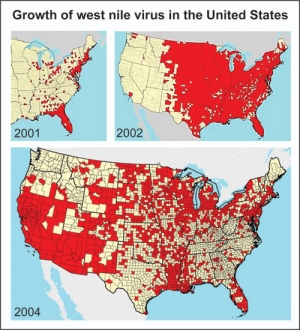Human Health
The World Health Organization (WHO) estimated in 2000 that 150,000 human deaths per year are tied to climate change.1 WHO researchers project the risk of death from global climate change impacts will more than double by 2030.

In general, health risks are greater for older and younger segments of the population.
Credit: ©Elena Korenbaum, istockphoto.com
Health risks are linked to climate change through direct and indirect cause-and-effect chains, and depend on factors such as a person’s age, health condition, economic status, access to quality healthcare programs, and exposure to the elements. In the Southwest, regional health risks linked to climate change include extreme heat conditions, poor air quality, and increased food-, water-, fungal- and animal-borne diseases.
Climate change may impact health risks due to:
- Societal factors that increase health risk
- Heat
- Precipitation
- Air quality
- Malnutrition
- Disease
Societal factors that increase health risk
Age or health condition: Older adults are more sensitive to temperature extremes and are more likely to have pre-existing medical conditions that could worsen due to climate change-related factors. Young children are also at a higher risk because they have a small body mass-to-surface ratio and faster breathing rates relative to body size, which makes it harder for them to cool off. People with compromised immune systems or other pre-existing medical conditions are also at higher risk of suffering negative health effects.
Economics and access: People with inadequate access to health care may be less able to cope with negative health consequences. Impoverished people, including those who have inadequate access to shelter, food, water, or cooling systems, will have a harder time adjusting to extreme weather. Migrants or new residents who are not acclimated to weather patterns have a lower awareness of local disease vectors, fewer social support networks, and reduced access to health care.
Exposure: Outdoor laborers will be directly subjected to changing weather patterns and weather extremes. Children and adults who participate in outdoor recreation will also be at higher risk. Undocumented migrants, particularly those crossing the Southwest desert, are often subjected to severe climate patterns while traveling to their desired destination. Residents in urban areas are exposed to temperatures between 2 and 10 degrees warmer than nearby rural areas as a result of the urban heat island effect.
Heat
Extreme heat, including heat waves and higher maximum temperatures, can directly cause heat stroke, heat exhaustion, or hyperthermia. Extreme heat also affects health by making chronic conditions worse.
Precipitation
If regional precipitation declines as projected, reservoir levels will drop, reducing the availability of water. Future changes in the intensity and frequency of storms, floods, and severe precipitation events will also hinder sanitation and water delivery infrastructure.
Air quality
Ground-level ozone formation, mainly created by burning fuels, increases at higher temperatures. Breathing ground-level ozone can result in lung inflammation or decreases in lung function, which may increase risk of asthma or premature mortality.
Climate projections indicate an earlier start for the pollen season for many North American plant species, lengthening the allergy season for those who suffer allergy attacks. Wildfires are projected to occur more often as temperatures increase and rainfall decreases, especially in arid areas, contributing to bad air quality. Smoke from wildfires can aggravate or cause asthma and chronic obstructive pulmonary disorder (COPD).
Malnutrition
Nearly 800 million people in the world suffer from the lack of an adequate food supply. Drought and temperature changes have direct impacts on crop yield and crop failure that can make less food available for people. Southwest agriculture could suffer as the climate becomes hotter and drier.
Disease
Water, food, plants, fungi, and animals are capable of spreading disease to humans, and all are directly tied to climate or exhibit distinct seasonal patterns.
Food-borne disease: Incidence of food-borne disease associated with fresh produce is growing. More intense storm events may result in contamination of food crops with feces from nearby livestock or feral animals.

Figure 1. In a matter of a few years West Nile Virus spread across the entire U.S.. Maps show cases of West Nile Virus documented by the Centers for Disease Control and Prevention.
| Enlarge This Figure |
Credit: Centers for Disease Control and Prevention
Water-borne disease: Untreated water can contain protozoa, parasites, bacteria, or viruses that cause a variety of diseases. Increased storm events may cause runoff of untreated water into the supply of human drinking water. These events particularly impact certain populations, including over 100,000 residents of colonias in New Mexico, who already have limited access to clean water. Colonias are areas of high poverty that lie outside city limits, usually along the U.S.-Mexico border, and often lack public infrastructure like plumbing, garbage service, or roads.3 These communities are extremely vulnerable to drought-induced health effects, such as increased disease transmission through water-borne vectors due to poor water quality.
Animal vectors: The reproduction and survival rates of protozoa, bacteria, viruses and their vector organisms (e.g. mosquitoes, mice) are affected by temperature variations. The changing climate will also affect vegetation, bringing invasive species and pathogens to new areas. In the Southwest, diseases associated with animal vectors include Hantavirus pulmonary syndrome and West Nile virus.
Hantavirus pulmonary syndrome is transmitted to humans through rodent droppings. The Southwest has the highest number of cases in the U.S., which researchers have linked to climatic variations.4
Two types of mosquitoes common to the Southwest carry West Nile virus, which causes fever-like symptoms in humans. Changes in temperature, humidity, vegetation, and land cover will affect the number and distribution of these mosquitoes.
Fungal pathogens: Spores from fungi can also cause diseases in humans when inhaled, such as valley fever. The range distribution of these fungi could be connected to climate change.
References
- World Health Organization. 2002. The world health report 2002: reducing risks, promoting healthy life. World Health Report, World Health Organization, Geneva, Switzerland.
- McMichael, A., et al. 2004. Global climate change. In Ezzati, M., A. Lopez, A. Rodgers, and C. Murray. (eds.) Comparative quantification of health risks: Global and regional burden of disease attributable to selected major risk factors. pp. 1543-1649. World Health Organization, Geneva.
- Liverman D. and R. Merideth. 2002. Climate and society in the US Southwest: the context for a regional assessment. Climate Research, 21: 199-218.
- Eisen, R.J., et al. 2007. A spatial model of shared risk for plague and hantavirus pulmonary syndrome in the southwestern United States. American Journal of Tropical Medicine and Hygiene,77(6): 999-1004.
- Comrie, A. 2005. Climate factors influencing coccidioidomycosis seasonality and outbreaks. Environmental Health Perspectives, 113: 688-692.

